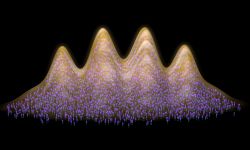
In a special issue of Nature Physics, Francesca Ferlaino and Matthew Norcia highlight the great potential of ultracold quantum gases from lanthanides. Despite their complexity, they are comparatively easy to access for experimental research and offer a wide range of possibilities for basic research and application.
A quarter of a century after the first creation of Bose-Einstein condensates, the journal Nature Physics publishes a focus issue on developments in the field of ultracold quantum gases and their potential in the future. For example, in what direction will atomic microscopes, optical tweezers, or new laser traps develop? What potential lies in quantum gases from lanthanides has been detailed by Francesca Ferlaino and Matthew Norcia from the Department of Experimental Physics at the University of Innsbruck and the Institute of Quantum Optics and Quantum Information of the Austrian Academy of Sciences in a review article in the special issue. When ultracold quantum gases were started to be condensed three decades ago, simple particles from the group of alkali or alkaline earth atoms, with only one or two electrons in their outer shells, such as lithium or rubidium, were chosen for this purpose. They were used to realize the first Bose-Einstein condensates, which was celebrated in 2001 when Eric Cornell, Wolfgang Ketterle and Carl Wieman were awarded the Nobel Prize in Physics.
A decade later, first research groups, including a team led by Francesca Ferlaino at the University of Innsbruck, were beginning to condense more complex particles, the lanthanides. These are silvery, relatively soft and reactive metals. Their atoms have many electrons in their outer shells, and they are also magnetic. "At first glance, this sounds like making life unnecessarily complicated, and at the time it wasn't clear whether these elements could be condensed in the same way as the simpler elements," Ferlaino says. "But as it turned out, after a lot of work, the lanthanides, especially erbium, were a stroke of luck: Because of the many ways they can absorb photons, cooling is actually easier. And the multiple ways in which these atoms interact make it possible to perform entirely new kinds of experiments." In 2012, for example, Francesca Ferlaino's team succeeded in condensing erbium for the first time. Since then, many research groups have realized these potentials, and there are now scores of groups around the world working on ultracold quantum gases of more complex elements. In the review article in Nature Physics, Ferlaino and Norcia present the properties of lanthanides and elaborate on their potential for research.